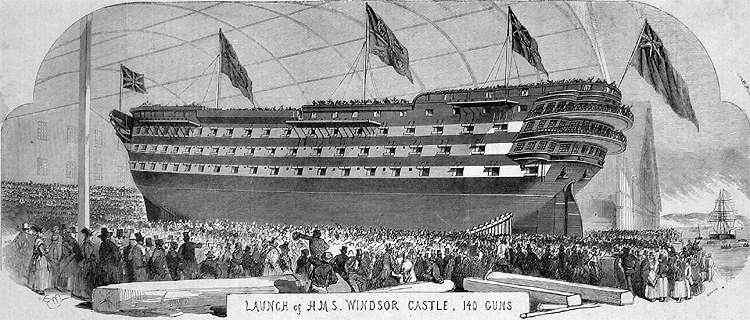H.M.S. Windsor Castle
A story from The Illustrated
London News of September 18th 1852
The Government, anxious
to augment our naval forces, some time since issued instructions
to the officers of the Royal Dockyard, Pembroke, to launch this
leviathan line-of-battle ship, with screw propeller, 140 guns,
with all possible despatch. Accordingly,the utmost exertion was
made to complete this vessel by Tuesday, the 14th instant, the
day officially fixed for the ceremony of the launching. The interest
taken in the matter was very great. On Monday week the admissions
to the Royal Dockyard numbered 500: carriage, horse, and foot
passengers thronged the establishment throughout the day, with
great interruption to the public service.
The novelty of the build of the Windsor Castle,
having originally been constructed for 120 guns, then cut in
two by a remarkable and unheard-of process, and lengthened in
midships some 23 feet, and the application of the screw-propeller
for the first time to so stupendous a war-vessel, have tended
to render her an object of peculiar interest. Her midships lengthening
was for the purpose of giving the necessary increase of displacement
for the engines, boilers, coals, etc., and that abaft for the
accommodation of the srew-propeller. The midship lengthening
was performed by cutting the ship asunder at " dead flat
' or the midship section, and launching the after half, weighing
about 2000 tons, the distance of 23 feet. This was done on the
3rd of February last, and occupied about an hour and a half.
The breadth and depth of the ship remain unaltered.
The dimensions of the ship have been furnished us from
authority. They are accurately as follow:
Length from fore part of
the figure head to aft part of taffrail, 278 ft. 6 in.
Ditto between the perpendiculars, 240 ft. 6 in.
Ditto of keel for tonnage, 201 ft. 11 1-3 in.
Extreme breadth, 60 ft.
Breadth for tonnage, 59 ft. 2 in.
Ditto, moulded, 58 ft. 4 in.
Depth in hold, 24 ft. 8 in.
Power of engines, 800 horse.
Burthen in tons, 3759 4.94.
Estimated weight of hull, 2732 tons.
Ditto, when fully equipped for sea, 5571.
Number of guns 140.
The Windsor Castle
will be the largest ship afloat in the whole world, and with
the addition of her screw propeller, will form a floating battery
of immense power.
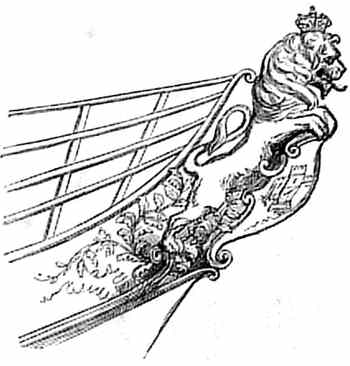
Her figurehead is a noble
piece of carving, containing upwards of 70 cubic feet of timber.
It was brought to Pembroke Dockyard by the Widgeon, which
vessel has superseded Prospero, a steam-tug, tender to
Saturn guard ship. HM steam-frigate Simoom has
also arrived at Milford, with masts and rigging for the Windsor
Castle.
Additional Information
HMS Windsor Castle was
launched on the day The Iron Duke, the Duke of Wellington, died
at Walmer. HMS Windsor Castle was renamed in his honour on 1st
October 1852. She went on to serve as flagship in the Baltic
during the Russian War but was later relegated to harbour service
in 1863 and used as a 'depot ship' for berthing the men of the
Portsmouth Dockyard Reserve. She was broken up in 1909.
Summary
Launched 14th September
1852.
Renamed 1st October 1852: HMS Duke of Wellington
Wooden hull. Screw propeller.
Type: 1st rate.
Burthen (Builders measure) 3771 tons.
Displacement 5829 tons.
Guns: 131.
Taken out of service in 1909.
Ships book in Public Records Office, London: 142.
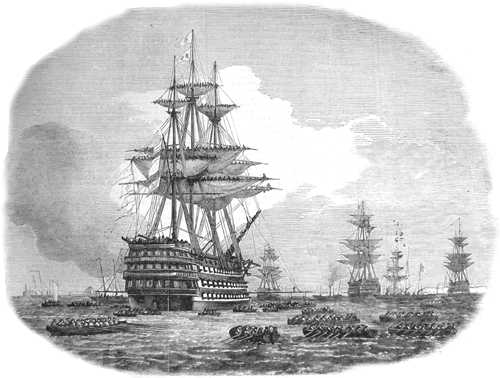
Midshipmen going
on board HMS Duke of Wellington
Now renamed 'The Duke of
Wellington', The llustrated London News published the engraving
above of the former 'HMS Windsor Castle' in their issue dated
October 20th 1855, fifty years after the famous defeat of the
French Navy by Nelson at Trafalgar. The ILN's caption, Midshipmen
going on board HMS Duke of Wellington, is accompanied by
a note in the text explaining that the engraving portrays the
magnificent flag-ship, with the lively incident of Midshipmen
going on board the vessel 'to copy the the orders of Admiral
Dundas'.
RMS Windsor
Castle
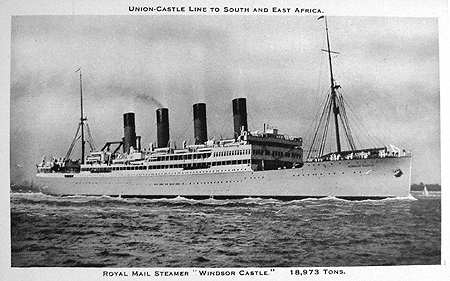
Built at John Brown,
Clydebank and launched March 9th 1921 by the Prince of Wales.
Converted in 1937 to two funnels and a reshaped bow and used
as a troop ship. Sunk May 1943. This website has several remarkable photos including her sinking.
The last liner to bear
the name was launched on 23rd June 1959 by HM Queen Elizabeth
the Queen Mother. This
website has a number of excellent photographs, including her breaking up in
India in 2005.
To be extended as pictures
come available.
SS Windsor Castle
Side-wheel steamship rigged
for sail
2 masts, 1 funnel, 2 wheels
The Wreck
of the Windsor Castle Steamer
As reported in The Illustrated London News
Oct 12th 1844 page 229
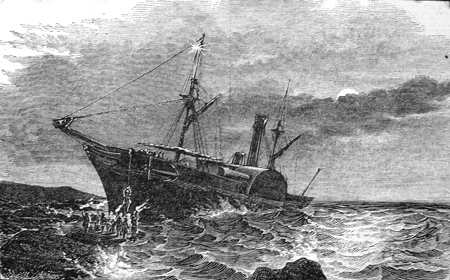
In our late edition of last week's journal,
we briefly recorded this appalling accident. We now proceed to
detail the circumstances, illustrated with a sketch of the vessel
by our artist, Mr. Landells, who was a passenger for the purpose
of sketching the closing incidents of the Royal Visit to Scotland.
It appears that the Windsor Castle sailed from Granton
to Dundee on Tuesday morning, with a great number of passengers,
to witness the embarkation of the Queen. The passage to Dundee
was performed both safely and with expedition, and about four
o'clock in the afternoon the Windsor Castle left the west protection
wall of Dundee with passengers to the number of nearly 250, on
her return home. The vessel steered directly out to the royal
squadron, which had not yet got under way, and sailed five or
six times round the 'Albert and Victoria', in order to gratify
the passengers with a view of Her Majesty and her royal consort,
both of whom appeared on the deck, and graciously acknowledged
the enthusiastic and oft repeated cheers of those on board the
Windsor Castle.
The royal yacht left the roadstead at half past four
o'clock, followed by the other steam vessels, and by the Windsor
Castle. When off the town of St. Andrew's the Victoria and Albert,
followed by the Black Eagle, the Princess Alice, the Stromboli,
and the Eclair, were seen far ahead, rapidly fading from the
sight. It was now half past seven o'clock; the vessel had reached
the East Neuk of Fife, and all things were apparently going on
safely and speedily (a party were dancing to music on deck),
when suddenly a loud cry was heard from those in the forecastle
to stop and back the engine, which was scarcely done the the
vessel, still under the impulse of its former velocity, came
with a tremendous crash against the beacon on the North Carr
Rock.
Instantaneously the air was rent with shrieks from
the women and children, the men rushing backwards and forwards
in great confusion. Some passengers clung to each other, appalled
at the prospect of immediate destruction; others, with great
presence of mind, began to lay hold of carpet-stools, pieces
of wood, and other lumber lying on the decks, by which they might
support themselves in the event of the vessel sinking, while
several gentlemen divested themselves of nearly all their clothes,
so that they might with more chance of success be able to sustain
themselves on the ocean. At the moment the vessel struck, a large
party were below at dinner. When the sea-water had attained a
considerable depth in the engine room and the main cabin, the
vessel lurched to one side; upon observing which, the passengers
rushed to the high side of the vessel, which was thus swung over
to the same side, causing the passengers to betake themselves
again to the opposite side; and thus the vessel was kept rolling
from side to side, the sea water being by the motion lashed up
on either side of the vessel's hold. In this awful and helpless
condition, the helm was put hard a-port; and after a lapse of
nearly twenty minutes, passed in gloomy suspense, the Windsor
Castle grounded, most providentially, as was afterwards found,
between two large rocks, a little to the east of Kilminning,
and about two miles from Crail. The only boat belonging to the
steamer was then lowered, by which the female passengers were
conveyed ashore in six voyages. Boats and other aid were then
obtained from Crail, and the remainder of the passengers were
providentially landed in safety. Up to this time the weather
had continued favourable; but it now began to blow a violent
gale, which continued all night, causing a heavy sea to beat
against the vessel; consequently, the steamer, on the return
of the tide, shifted from its first position, and was driven
violently on a ledge of rocks close by, against which it continued
to grate till it was broken in the back, and became a total wreck.
It is stated that had the vessel struck the North Carr Rock stem
on, she would immediately have split in two. As it was, she made
a sliding stroke over the rock, some of the iron staunchions
of the beacon, by the concussion opened up the joining of two
plates immediately under the bulkhead, through which the water
rushed into the vessel.
The Windsor Castle is stated have been built on the
Clyde, and to have been one of the strongest iron vessels of
her size afloat.
Mr Landells, at the moment the vessel struck, was
in the after-cabin, in conversation with the steward; and before
they got on deck she went right over on her beam-ends. Mr. Landells
adds:-" My first thought was to fill my life-preserving
coat, which I did directly; and, on looking round, saw the beacon
against which we had struck, which I at first took for the funnel
of another steamer, which I supposed we had run foul of. The
captain immediately ordered her head to be put in shore, and
we made all speed towards it. By this time I had mounted to the
top of the paddler box, where I remained till we came in sight
of land, when all fear left me. I cannot give you any idea of
the scene on deck: all were looking with eager eyes towards the
shore, except a group of perhaps twenty or thirty persons, that
seemed to have given way to complete despair, yelling, shouting,
and ringing their hands. In the fore part of the ship, I saw
twelve persons holding on by a plank. They had lifted one end
off the deck, and placed it on the gunwale of the ship: thus
they patiently waited the result. On the vessel being stopped,
the screams were again as loud and terrific as when we first
struck; the ship gave one or two rolls, and then settled very
quietly upon the rock.
Three large fishing boats from Crail came very quickly
towards us, having the wind and tide in their favour. When they
left, there were yet about ten or twelve of us remaining on deck.
The boatmen promised to return as soon as they could; they had
got about two miles to go before they could land and we had no
hope of getting off till they returned. As the tide had fallen,
so that neither the small boat nor the large one could land near
the wreck, I now went forward with some friends on board to see
what sort of a place we were in. The moon got out, and we were
delighted to see the vessel was quite dry at the bows. I then
got down from the bows by rope and landed safely; several people
came towards us with torches. I got my bag and coat thrown down
to me, and while my friends were getting out, I made the sketch
which you will have in the ILLUSTRATED LONDON NEWS this week.
It was a romantic scene: the huge black looking ship, the moon
lighting the sea, the black rocks, and the people with torches,
altogether made a fine effect. To get to the shore was yet a
difficult task, as the rocks were so very rough; but we succeeded
and got to our inn. I went down to the wreck next morning, and
was surprised to find it covered with water.
I waited till the tide went down a little, and got
a boat, and went on board to see if I could save my box. The
vessel had broken in two, and every thing was floating about
in the greatest confusion; she had a pretty cabin, and it was
quite painful to see the beautiful furniture and fittings floating
about at the mercy of the sea. We We saved a few passengers'
luggage, but I could not find my box, and returned to shore,
thinking it had washed away. On my landing, one of the Coastguard
men told me there were two boxes at a cottage a little way off,
and, to my joy, one of them was mine. I put it on my shoulder,
and had to carry it about three miles along a coast, the like
of which I never saw before, or wish to see again."
This catastrophe presents another instance of the
inefficient manner in which steam vessels are provided with the
means of escape in case of accidents. "In this case, it
is truly awful to think that, had the vessel gone down immediately,
there was no apparent means by which, in any human probability,
one of 260 individuals on board could have been saved. There
was only one boat, and that so small as to be incapable of holding
more than half a dozen persons, which, in the frenzy of the moment
would have been, undoubtedly, swamped by the eager multitudes
rushing into it. Does not such a state of matters call upon the
Government to devise some means of compelling every sea-going
steam vessel to carry at least two or three good boats? The paddle
box boats of Captain Smith have been found in several instances
of invaluable service, and every steam-vessel should be provided
with them, or with other efficient means of preserving life in
cases of danger. The Windsor Castle had also no apparatus for
making signals, neither gun nor rocket was on board, and vain
was the attempt of the despairing multitude, by uniting their
voices, to bring help from the nearest land, which, at least,
was four miles distant from them."
|

